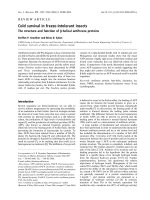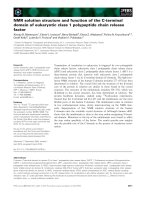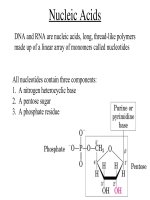Day one nucleic acid structure and function
Bạn đang xem bản rút gọn của tài liệu. Xem và tải ngay bản đầy đủ của tài liệu tại đây (5.87 MB, 105 trang )
All nucleotides contain three components:
1. A nitrogen heterocyclic base
2. A pentose sugar
3. A phosphate residue
Nucleic Acids
DNA and RNA are nucleic acids, long, thread-like polymers
made up of a linear array of monomers called nucleotides
Ribonucleotides have a 2’-OH
Deoxyribonucleotides have a 2’-H
Chemical Structure of DNA vs RNA
Structure of Nucleotide Bases
Bases are classified as Pyrimidines or
Purines
The nucleus contains the cell’s DNA (genome)
RNA is synthesized in the nucleus and exported
to the cytoplasm
Nucleus
Cytoplasm
DNA
RNA (mRNA)
Proteins
replication
transcription
translation
dA
dG
dT dC
Deoxyribonucleotides found in DNA
Nucleotides are
linked by
phosphodiester
bonds
Bases form a specific hydrogen bond pattern
DNA is double stranded
The strands of DNA are antiparallel
The strands are complimentary
There are Hydrogen bond forces
There are base stacking interactions
There are 10 base pairs per turn
Properties of a DNA
double helix
DNA is a Double-Helix
RNase P M1 RNA
Transcription of a DNA
molecule results in a mRNA
molecule that is single-
stranded.
RNA molecules do not have a
regular structure like DNA.
Structures of RNA molecules
are complex and unique.
RNA molecules can base pair
with complementary DNA or
RNA sequences.
G pairs with C, A pairs with U,
and G pairs with U.
bulge
internal
loop
hairpin
Nucleic Acids in Acid and Base
The glycosidic bond of DNA and RNA is hydrolyzed by acids.
Order of stability: dA, dG < rA, rG < dC, dT < rC, rU
dA, dG hydrolyzed in boiling 0.1 M hydrochloric acid in 30 min
rA, rG hydrolyzed in boiling 1 M hydrochloric acid in 60 min
rC, rU hydrolyzed in boiling 12 M perchloric acid in 60 min
DNA is quite stable under basic conditions.
RNA is readily hydrolyzed by base.
RNA is hydrolyzed under alkaline (basic) conditions
Methylation of Nucleotide bases
Certain nucleotide bases in DNA molecules are methylated, catalyzed by enzymes.
Adenine and Cytosine are methylated more often than Guanine and Thymine.
Methylation is confined to specific regions of DNA and aid in biological processes.
E. coli DNA is methylated to distinguish its DNA from that of foreign invaders.
In eukaryotic cells about 5% of cytidines are methylated, producing 5-methylcytidine.
Spontaneous Alterations in Nucleic Acids
In a human cell, DNA undergoes spontaneous alterations in structure (mutations).
As a cell ages, the number of mutations increases, making it likely that a cell’s
normal processes may be altered.
There is a link between spontaneous mutation, aging, and carcinogenesis.
Depurination
If DNA contined uracil, during replication of DNA the
uracils would be base-paired with adenine.
Deaminated cytosines would also be base-paired with adenine.
This would decrease the number of G-C base pairs over time
and increase the number of A-U base pairs.
Eventually all the G-C base pairs could be lost.
The genetic code would not exist as we know it.
Why does DNA contain thymine and not uracil?
Ultraviolet light is damaging to DNA
Near-UV radiation (wavelengths of
200 – 400 nm) is a significant
portion of the solar spectrum.
Upon exposure to ultraviolet
radiation, two adjacent pyrimidine
bases can dimerize.
This happens most often between
two adjacent thymines.
Two products often form:
cyclobutane thymine dimer
6-4 photoproduct
Nucleic Acids
Where are they found in nature?
and
What do they look like?
Genomes
Source of DNA Size (bases) Type
Escherichia coli 9,200,000 Closed-circular double-stranded DNA
Bacillus subtilis 4,200,000 Closed-circular double-stranded DNA
F plasmid 95,000 Closed-circular double-stranded DNA
λ phage 48,500 Linear double-stranded DNA
T7 phage 40,000 Linear double-stranded DNA
M13 phage 6,400 Closed-circular single-stranded DNA
MS2 phage 3,600 Linear single-stranded RNA
Human 6,000,000,000 Linear double-stranded DNA
Fruit fly 270,000,000 Linear double-stranded DNA
HIV 9,700 Linear single-stranded RNA
DNA molecules are packaged in the cell as structures called chromosomes.
Bacteria have a single chromosome. Eukaryotes have multiple chromosomes.
A single chromosome contains thousands of genes, each encoding a protein.
All of an organism’s chromosomes make up the genome.
Humans have 46 chromosomes.
The human genome has about 3 billion nucleotide base pairs.
The Human Genome
E. coli has a single double-stranded
DNA molecule as its genome.
There are 4,639,221 base pairs
in the E. coli genome.
The DNA is 1.7 mM long,
850 times the length of an E. coli cell.
plasmid
Large DNA molecules
are compacted in a cell
by supercoiling.
relaxed supercoiled









